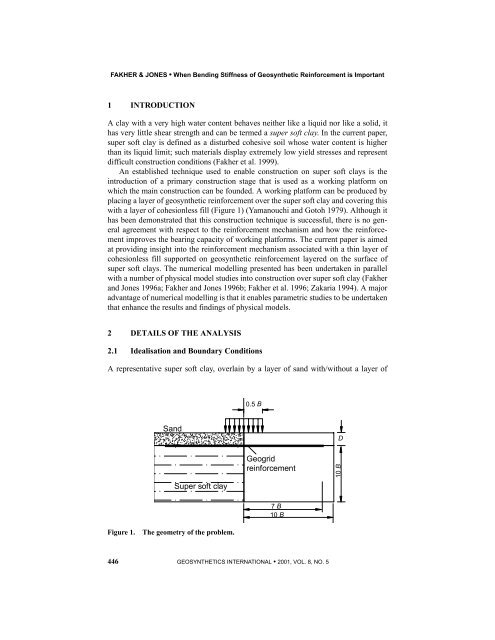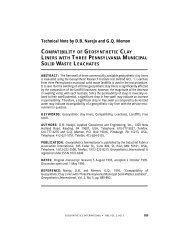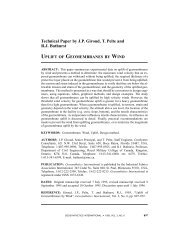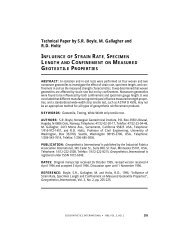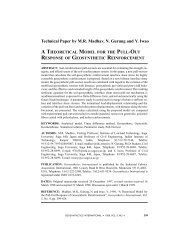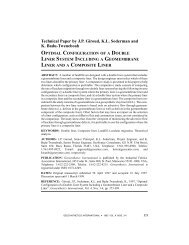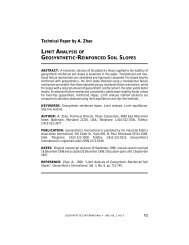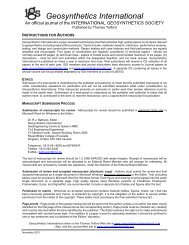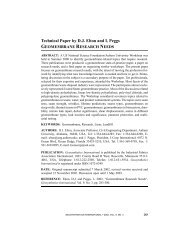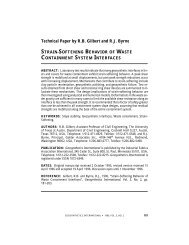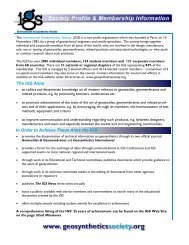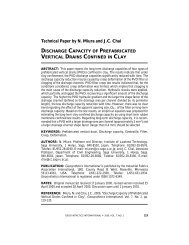Technical Paper by A. Fakher and C.J.F.P. Jones WHEN THE ...
Technical Paper by A. Fakher and C.J.F.P. Jones WHEN THE ...
Technical Paper by A. Fakher and C.J.F.P. Jones WHEN THE ...
Create successful ePaper yourself
Turn your PDF publications into a flip-book with our unique Google optimized e-Paper software.
FAKHER & JONES • When Bending Stiffness of Geosynthetic Reinforcement is Important<br />
1 INTRODUCTION<br />
A clay with a very high water content behaves neither like a liquid nor like a solid, it<br />
has very little shear strength <strong>and</strong> can be termed a super soft clay. In the current paper,<br />
super soft clay is defined as a disturbed cohesive soil whose water content is higher<br />
than its liquid limit; such materials display extremely low yield stresses <strong>and</strong> represent<br />
difficult construction conditions (<strong>Fakher</strong> et al. 1999).<br />
An established technique used to enable construction on super soft clays is the<br />
introduction of a primary construction stage that is used as a working platform on<br />
which the main construction can be founded. A working platform can be produced <strong>by</strong><br />
placing a layer of geosynthetic reinforcement over the super soft clay <strong>and</strong> covering this<br />
with a layer of cohesionless fill (Figure 1) (Yamanouchi <strong>and</strong> Gotoh 1979). Although it<br />
has been demonstrated that this construction technique is successful, there is no general<br />
agreement with respect to the reinforcement mechanism <strong>and</strong> how the reinforcement<br />
improves the bearing capacity of working platforms. The current paper is aimed<br />
at providing insight into the reinforcement mechanism associated with a thin layer of<br />
cohesionless fill supported on geosynthetic reinforcement layered on the surface of<br />
super soft clays. The numerical modelling presented has been undertaken in parallel<br />
with a number of physical model studies into construction over super soft clay (<strong>Fakher</strong><br />
<strong>and</strong> <strong>Jones</strong> 1996a; <strong>Fakher</strong> <strong>and</strong> <strong>Jones</strong> 1996b; <strong>Fakher</strong> et al. 1996; Zakaria 1994). A major<br />
advantage of numerical modelling is that it enables parametric studies to be undertaken<br />
that enhance the results <strong>and</strong> findings of physical models.<br />
2 DETAILS OF <strong>THE</strong> ANALYSIS<br />
2.1 Idealisation <strong>and</strong> Boundary Conditions<br />
A representative super soft clay, overlain <strong>by</strong> a layer of s<strong>and</strong> with/without a layer of<br />
0.5 B<br />
S<strong>and</strong><br />
D<br />
Super soft clay<br />
Geogrid<br />
reinforcement<br />
10 B<br />
7 B<br />
10 B<br />
Figure 1.<br />
The geometry of the problem.<br />
446 GEOSYN<strong>THE</strong>TICS INTERNATIONAL • 2001, VOL. 8, NO. 5


